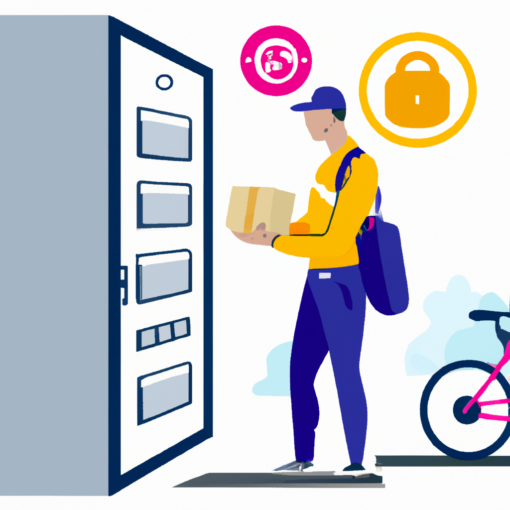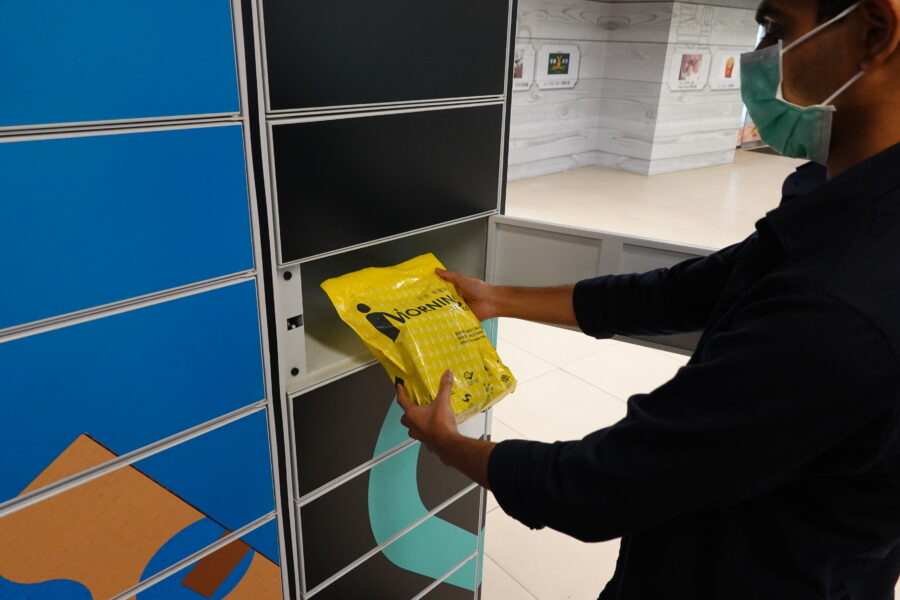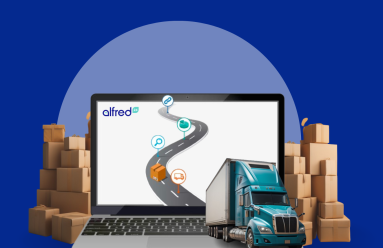What is a smart locker?

A smart locker is an innovative, digital locker that incorporates modern technology to provide enhanced security and efficiency for storing and delivering various parcels.
In contrast to traditional lockers, smart lockers utilize advanced components.
Such as electronic locks, sensors, cameras, and network connectivity to enable more sophisticated functionality.
Including real-time tracking, secure access control, and notifications.
They allow consumers to receive multiple product types in multiple sizes that are required to be kept hot, cold, or temperature controlled.
Smart lockers are the post box for the 21st century.
The rise of e-commerce and the ever-increasing demand for secure, convenient, and efficient storage solutions have spurred the development of smart lockers.
These advanced, digital lockers are becoming more prevalent in various sectors and locations, from retail to residential settings.
As we continue to embrace the digital age, it becomes imperative to understand smart locker technology and how it’s shaping our world.
This blog post aims to uncover the ins and outs of smart lockers, how they work, their substantial benefits, and the numerous applications they serve.

The Evolution of Lockers
Lockers have been around for centuries.
The first lockers were used in medieval times to store armor and weapons.
In the 1800s, lockers were used in schools and factories to store personal belongings.
These lockers were made of wood and had simple combination locks.
Over time, lockers evolved, and in the 1970s, coin-operated lockers became popular.
These lockers were used in public spaces like train stations and amusement parks.
However, they had limitations as they required coins, which were often not readily available, and they were prone to theft.
Understanding Smart Lockers
Available in numerous sizes and designs, smart lockers are commonly situated in public spaces.
Like shopping malls, airports, residential buildings and central smart locker locations.
They serve as storage and retrieval centers for packages.
Adding a layer of convenience for individuals and businesses seeking modern solutions to traditional delivery methods.
Fundamentally though, they also offer consumers the flexibility to pick up any kind of parcel, from any location at any time.
With deliveries within 24 hours, they’re the evolution of e-commerce and click-and-collect into 2023.
Covid-19 sped up the transformation of the world into an online-offline model, with smart lockers a key part of that enabler.
With the smart locker market set to grow 19% year on year to $1.8bn by the end of the decade.
Having the right software and locker network in place for this growth in going to be paramount for providers looking to ride this wave.
Features of a Smart Locker
Some of the features of a smart locker include:
1. Electronic Locks
Smart lockers are equipped with electronic locks that can be controlled remotely.
These locks are more secure than traditional locks as they cannot be picked or forced open.
2. Mobile Access
Smart lockers can be accessed using a smartphone app.
This allows users to open the locker remotely and track the items they have stored.
3. Multiple Access Options
Smart lockers can be accessed using a code, a card, or a biometric scanner.
This allows users to choose the most convenient and secure access method for their needs.
4. Tracking and Monitoring
Smart lockers are equipped with sensors and cameras that can track the usage of the locker.
This allows administrators to monitor the locker’s usage and detect any unauthorized access.
5. Customizable
Smart lockers can be customized to meet the specific needs of the user.
For example, they can be designed to store different types of items, such as laptops or gym gear.

The Mechanics of Smart Lockers
The operation of smart lockers depends on a comprehensive network comprising three core elements: hardware, software, and cloud-based connectivity.
- Hardware: The foundation of smart lockers lies in the combination of sensors, cameras, and electronic locks. These components collaborate seamlessly to manage item storage, delivery, and retrieval securely and efficiently.
- Software: Powering the entire locker network is software that orchestrates communication between lockers, handles delivery requests, and sends notifications to customers when their parcels are available for pick-up.
- Cloud-Based Connectivity: Central to smart locker functionality is cloud-based connectivity that establishes real-time monitoring and management of the locker system from remote locations, providing users with access to the locker system from virtually anywhere with an internet connection.
The Benefits of Smart Lockers
1. Enhanced Security
Smart lockers boast state-of-the-art security features, such as secure access control, sensors, and cameras.
A secure locking and a unique access code (known only to the owner) ensure items remain safe until the rightful owner retrieves them.
Clearly a much-improved process than leaving parcels outside the door or with a neighbor.
2. Unmatched Convenience
Thanks to smart lockers, the days of staying home to receive packages are long gone.
Customers have the freedom to access their packages whenever they choose by simply entering the designated code to unlock the locker, regardless of whether it is day or night.
For example, smart lockers allow customers to order e-commerce products the night before.
And pick them up from a smart locker on their way to work, or vice versa.
Because smart lockers are centrally located, this gives 3PLs the chance to shorten their delivery lead time.
With 88% of consumers surveyed saying they would pay more for same-day delivery.
3. Elevated Customer Experience
Improved control over the delivery and storage of their items offers users an elevated customer experience when utilizing smart lockers.
The automated delivery process and intuitive user interface make accessing parcels in smart lockers hassle-free and efficient.
Simply add the code to the smart locker and pick up the package at any time of the day or during the commute.
4. Cost-Effectiveness
Consolidating multiple deliveries into one location makes smart lockers a cost-effective alternative to more traditional delivery methods like home delivery or courier services.
This approach enabled by smart lockers saves on delivery costs and minimizes the carbon footprint by reducing the number of vehicles needed for individual package deliveries.
5. Increased Operational Efficiency
Incorporating smart lockers into a business model can enhance operational efficiency by automating the delivery process and improving visibility.
Smart locker technology does this by managing the entire two-sided process in one place.
Reducing delivery times, increasing efficiency, and simplifying the entire process.
6. Customizable
Smart lockers can be customized to meet the specific needs of the customer.
For example, they can be designed to store different types of items, such as laptops or gym gear.
As well as receive temperature control items such as hot and cold food or perishables.
7. Enhanced Sustainability
With consumers demanding sustainability in all aspects of the value chain, smart lockers are arguably a key cog in this green machine.
Smart lockers help to make e-commerce more sustainable by only delivering to one central lockers location.
This means deliveries are consolidated and less of them occur.
Additionally, deliveries can be done at night and can be planned for optimal traffic conditions, meaning less pollution, and less damage to the planet.
Finally, Packaging that is bio-degradable that doesn’t use micro-plastics is another way in which smart lockers are helping to make deliveries green.
Learn more about what a sustainable supply chain looks like here.

Diverse Applications of Smart Lockers
1. Retail Delivery
Installed in convenient public spaces such as hotels or shopping malls.
Smart lockers give customers the freedom to collect their packages whenever they desire, no matter the package.
2. Workplace Management
In an office setting, smart lockers serve as a practical solution for managing internal deliveries or providing employees with secure storage facilities for personal items.
Saving the need for security or receptionists to pick up parcels.
3. Residential Buildings
Residential buildings are beginning to utilize smart lockers, providing residents with hassle-free access to their packages without the need for interaction with delivery personnel.
This evolution is a game changer for residents.
Now they have a post-box that is updated for the 21st century that can accept cold or hot food, personal items, and delicates.
It’s like having your own personal concierge.
4. University Campuses
Students at university campuses can benefit from smart lockers as a secure storage option for textbooks, study materials, or other essential items.
Taking the school locker to the next level, smart lockers give students the utility to leave any item in their locker in-between classes, events, or days.
5. Parcel Delivery Companies
Parcel delivery companies are also tapping into the smart locker revolution.
Providing customers with a means to receive packages at self-service collection points that do not require in-person delivery scheduling.
This allows them to deliver more packages, faster, with fewer deliveries required, as deliveries are consolidated into central locations.
Fewer deliveries = better health for our planet.
Conclusion
As the world becomes increasingly digital, smart lockers present a practical and efficient solution for businesses and customers alike.
Offering secure storage and delivery alternatives, smart lockers are revolutionizing not only the retail landscape.
But a variety of sectors such as residential and education facilities.
As e-commerce continues its upward trajectory, we can expect to see more businesses integrating smart lockers into their strategies, and with it, advancements in locker technology that will shape the future of parcel delivery and storage solutions.


